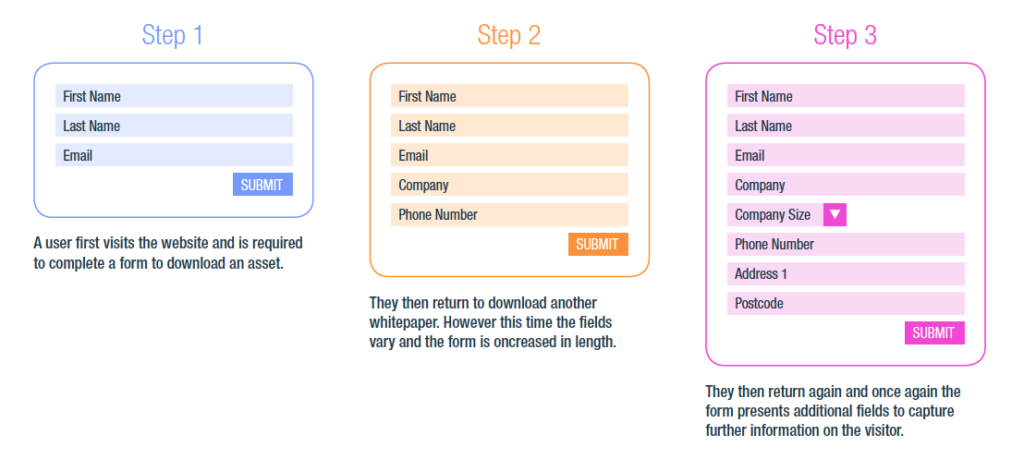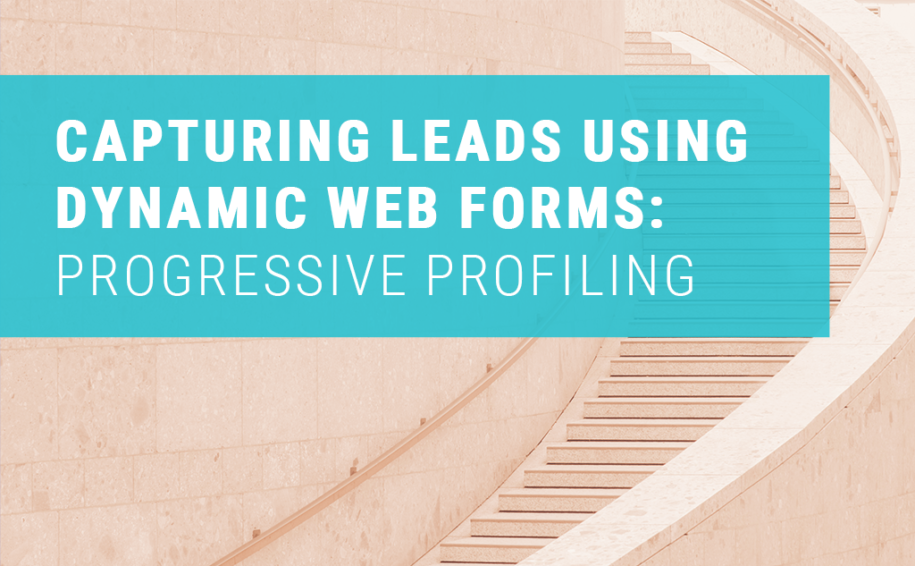Progressive profiling is the practice of gradually building data on a lead through multiple dynamic web form submissions. It enables this by utilizing the exchange on a website for something of value (i.e. contact details) for something that a prospect is interested in, like a guide or webinar. Using dynamic web form questions that become more in-depth each time a lead visits a site allows marketing teams to gain incremental information on their prospects and customers.
A more technical definition of progressive profiling is the process for cumulatively gaining additional data on a contact through additional form submissions. So ultimately, the more often a prospect accesses your site, the more data you build on them – in this case it’s through web forms.
This functionality isn’t new and marketing automation platforms have had the ability to carry out this function for a while. However progressive lead profiling isn’t always a straightforward solution. Requiring a heavy amount of input initially from both marketing teams and tech teams, it should be integral to your gating strategy. Yet due to the wide range of options and varying opinions across marketing teams, deployment isn’t always easy or effective.
This article aims to clarify the various ways dynamic progressive profiling can improve conversion rates, enhance user-experience and save valuable time. We also discuss some common issues that can arise when implementing progressive profiling and how to avoid them.
Example of dynamic progressive profiling in action
In the illustration below, the web forms ask for the important data to build up a lead’s profile. Step 1 starts with the broad but critical fields, Name and Email. The second step then asks for more details with an increase in fields, including company and phone number. Finally, Step 3 elaborates even further, asking for company size and address and capturing even more data on the visitor. As the user gives this information over time and for the exchange of several assets on the website, they do not feel the pressure of giving too much information too soon.

Each time the user visits the site, we are able to increase our profile insight in increments. It’s far less intimidating than using the long form first – requesting all that information on the first visit may cause friction resulting in them not submitting the form at all.
Building data should not only useful for your lead gen tactics, it should benefit your website users first and foremost. Because your users need to be a reason to keep returning to your site and using your assets. The key is also in having enough valuable assets on your site that encourages your leads to return again and again. By using dynamic progressive lead profiling, helping your customers to solve their business queries goes hand in hand with your marketing strategy.
4 ways that progressive profiling benefits your user
Get to know your customer
Progressive profiling is the easiest way to get to know your buyers and understand their wants and needs. It helps you to identify what types of asset that they find high value and what information they are willing to exchange for it. It also helps identify which issues drive your users.
Lead generation and improved conversion rate
The more data you have, the more ways you can increase segmentation of your marketing campaigns and target your leads in a systematic way. And while sophisticated marketing automation platforms can enable this (outlined below), the more bespoke this journey can be, the more likely your leads are to convert. As you can imagine, asking for a lot of information at once can put your lead off, whereas the main benefit of progressive profiling is the ability to spread your questions out over time, building trust and gaining valuable data.
Enhanced UX
Asking critical questions progressively builds trust with your lead as well. This improves your website’s user experience as users see your site as a trusted information source and encourages them to return for new information.
Apart from avoiding query repetition, which affects user experience negatively, progressive profiling technology can save you time. By using form templates, you are able to re-use the same form for a multitude of assets rather than having to create separate forms for each landing page.
Comparing Progressive Profiling between marketing automation platforms
If your enterprise company already uses a marketing automation platform like Eloqua or Marketo, you might find the standard progressive profiling options acceptable to use. Below, we describe how to implement Progressive Profiling on four key marketing automation platforms as well as some limitations you may face.
Eloqua | Marketo | Pardot | Hubspot |
Eloqua Progressive lead profiling is added in the form editor.
Fields are grouped or a specific amount are shown each new form submission.
Must be deployed to Eloqua landing page or website running Eloqua tracking script. | Marketo Progressive lead profiling is activated in Form Settings.
You specify the number of blank (non-prefilled) fields shown each time.
Only works on Marketo landing pages using Insert Element option.
| Pardot Progressive lead profiling is added to individual fields when creating a form.
Fields can show only if there are pre-filled values in other fields.
Only works with Pardot Forms not Form Handlers | Hubspot Progressive lead profiling is added when editing a form.
Fields are placed in a queue below the main form editor.
Fields in the main form are selected to be replaced by queued fields when pre-filled. |
Common challenges in Progressive Profiling deployment
Challenges that arise around implementing progressive profiling usually have to do with similar factors across businesses.
Aligning the business (by business unit or region) to agree varying requirements can increase the complexity of implementation. For example, the enterprise solutions team can choose to add a custom question on the standard ‘medium’ gate form. It only shows on forms related to them.
Take a company with both US and German sites for example. Americans need a zip code for postal routing. Germany does not require it. So if the user is from Germany, the standard fields on the form need to change to remove the zip code (or regional code) field. In an ideal world, the company’s progressive profiling solution is flexible enough to handle regional requirements such as these.
Innovative uses of Progressive Profiling
Progressive profiling can give you valuable insight if you follow some basic best practices, such as:
- Ask the most critical questions first. Start with your broad requirements and become more specific on each return. You can build trust with your forms and you will be able to send more relevant content to the leads as you segment them later in their journey.
- The sales cycle will help you align the questions. Keep the information relevant to the stage of conversion your lead is in. As you plan your strategy, it’s a good idea to review your buyer journey and life cycle of a client to hit those conversion points.
- Utilize conditional form fields, meaning that you can change the rest of the form to coincide with the new information you gain. For example, if you learn the job title of a user in Step 1, ask what their biggest challenge is in Step 2. This gives you key insights into what the buyer’s challenges are and at what stage they may start needing support from your organisation.
Thinking outside of the box with dynamic progressive profiling can yield impressive results. You might find that the standardized version of progressive profiling offered through your marketing automation platform limits what you can do and how quickly you can implement your forms.
Gated Content.com offers solutions that are bespoke and work with your marketing automation platform to simplify dynamic progressive profiling. Get in touch to find out how we can help your team implement progressive lead profiling and give your lead generation efforts a boost!
